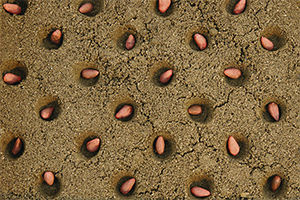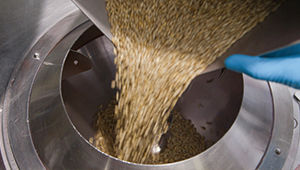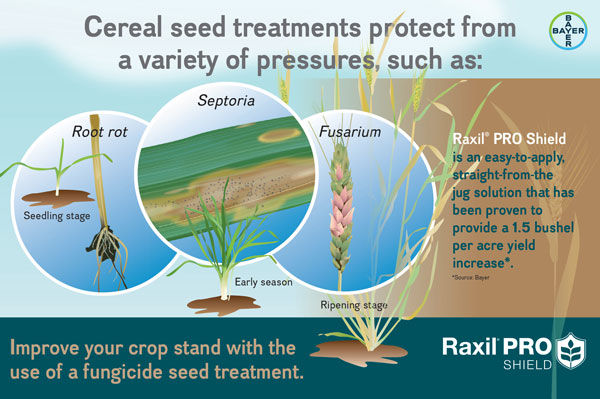Benefits of Cereal Seed Treatments
April 23, 2019

Guard Your Investment
For cereal growers every year, investments in careful planning, precision technology, labor and fuel are poured into choosing, spacing and placing each tiny seed for optimum germination.
“Seed treatment is the foundation of a great start. It should be in growers’ plans at all times.”
Bill O’Haire, Wilbur-Ellis Agribusiness, Great Falls, Mont.
Unguarded in the soil, however, that investment may be at risk to a host of soilborne threats.
Fungal pathogens such as Fusarium, Pythium and Rhizoctonia can lurk in soils, sometimes for years. Pests such as wireworms love to snack on cereal seeds, and aphids try to munch on tender seedlings.
To help each kernel reach its full potential, particularly during its most vulnerable early stage, a critical but sometimes overlooked defense is seed treatment.
Seed treatments work in two primary ways: by extinguishing invisible pathogens and by providing protection during germination.
Seed treatments immediately confer protection against fungal pathogens and insect pests such as wireworms and aphids. The active ingredients remain in plant tissue for three to four weeks. “That’s vital for the seedling to become established and stronger so it can eventually protect itself,” says Alan Dyer, associate professor of plant sciences and plant pathology at Montana State University (MSU).
Bill O’Haire with Wilbur-Ellis Agribusiness in Great Falls, Mont., provides seed-treatment and inoculant support for the state of Montana. Called “the godfather of seed treatments,” O’Haire says the decision to treat is more important than ever.
“Seed treatment is the foundation of a great start,” he says. “It should be in growers’ plans at all times. When they are making plans to grow a cereal, they should also be thinking about their seed treatment.”
Not Your Father’s Seed Treatment

Farmers today keep a sharp eye on their cropping systems and trends, Dyer says. “They’re a different breed than they were a generation ago,” he says.
So, too, are today’s seed treatments, which have left the old formulations in the dust. “Modern seed treatments are significantly better than they were even 10 to 15 years ago,” Dyer says. “They are so easy to put into a system, and they’re much better targeted. They affect just that 2” zone around the seed and crown.”
The new generation of treatments also has a broader spectrum of control than in the past, increasing the ability to tackle an entire disease complex.
“We're seeing protection against crown rots like we never have before,” Dyer says.
Seed coverage has shown improvement, too. Superior formulations significantly reduce dust-off and allow the product to flow more smoothly in the auger. In addition, some seed treatments have supplements that boost seedling energy, further protecting seeds from stressors.
Seed treatments are now “one of the least expensive and safest methods of pest control,” notes MSU’s “Small Grain Seed Treatment Guide,” updated in November 2017 and co-authored by Dyer.
Benefits of Seed Treatments
While soil type, environmental conditions and pest pressure can affect stand and yield, seed treatments provide a wide range of proven, cost-effective benefits:
“If you use bin-run seed consecutively, you should consider using a fungicide seed treatment to avoid an epidemic from a seedborne disease.”
Andrew Friskop, North Dakota State University (NDSU)
1. Early-season protection against pathogens
“If you use bin-run seed consecutively, you should consider using a fungicide seed treatment to avoid an epidemic from a seedborne disease.”
Andrew Friskop, North Dakota State University (NDSU)
Seed treatments create a zone around the seedling to disrupt pathogens that thrive in cool, moist conditions, such as Pythium. This helps the seedling fight later-season, opportunistic fungal pathogens that favor drier conditions, such as Fusarium, says Andrew Friskop, assistant professor and cereal Extension pathologist at North Dakota State University (NDSU).
“We manage Pythium, Fusarium and common root rot as a complex, because you’re likely to have two or sometimes three of them in a field,” he notes.
Growers planting bin-run seed may not be able to detect low levels of disease infecting their grain, such as bunts and smuts. Seed treatments can prevent their spread in the soil. “If you use bin-run seed consecutively, you should consider using a fungicide seed treatment to avoid an epidemic from a seedborne disease,” Friskop says.
2. Early-season protection against insect pests
A contact insecticide controls insects that try to bite seeds, whereas a systemic insecticide is taken up by plant tissue to repel feeding insects.
Preventing early-season feeding injuries is another way to guard plant vigor, leading to a healthier stand. “In North Dakota, particularly the western part of the state, wireworms are the number-one threat,” Friskop says. “Wireworm injury can stress the plant to the point where you might see more root rots occur.”
3. A healthy start

These two protections work in tandem to ensure a more vigorous cellular structure and stronger roots to help the plant actively resist pathogens as it grows.
For Rick Marsh, an agronomist with Southwest Grain in Dickinson, N.D., the most dramatic evidence for seed treatments can be found right under our feet. “Growers who insist their corn, soybeans or canola seed are fully treated with fungicides and insecticides are the same ones who turn around and drop their cereals in the ground with no treatment,” he says. “But once you dig up roots to show growers the difference in root health between treated and untreated cereals, they never go back. Guys who seed treat for the first time tell me, ‘What an eye opener!' It’s the first thing they put on their calendar for the following year.”
Strong roots help buffer environmental stressors, including dry conditions. “That is when we often see dramatic differences between treated and non-treated seed,” Dyer says. “During drought, plants need to pull water from 2’ to 4’ into the soil profile. They can't do that if their root systems have been heavily damaged by Fusarium or pruned by a Cochliobolus.”
4. A safer application
The targeted zone for seed treatments is under the soil rather than in a spray.
“Seed treatments are safer today than they were a decade ago,” Dyer says. “They are extensively tested to make certain they don't persist in the soil.”
“Seed treatments with a systemic insecticide also require less overall chemistry. Certain insects try to take a bite of a treated seed and may die. That means you don't have to spray the whole field later,” O’Haire says.
Seed treatments help prevent resistance, too. “That's one of the cool things about seed treatments – they don’t have heavy selective pressure on pathogens like foliar fungicides do,” Dyer says.
5. More consistent stands and better yields

“You should see a tremendous improvement in your stand with a seed treatment versus no seed treatment,” Dyer says.
O’Haire stresses that a seed treatment helps ensure the best stand possible. “Stand equals profit,” he says.
NDSU conducted 41 trials from 2003 to 2017, a stand improvement was seen 73% of the time with a fungicide seed treatment. “The general trend is that you will see a stand improvement,” Friskop says.
MSU conducted studies across four location-years of data and found new seed treatments, on average, improved yields 2 bu. to 4 bu. per acre in winter wheat. “Even with low disease pressure, seed treatments should provide 2 bu. per acre. But you also have to recognize that in some situations, the response will be much greater,” Dyer says. “We can have tremendous improvement in yield, up to 15% to 20% or more. We sometimes see as much as a 40% yield improvement.”
“I would not be surprised if we were to find a similar benefit from spring wheat. The crown rots are much more damaging to spring cereals, and that is one place where we are seeing real improvements in seed treatment performance.”
It’s important to look at the bigger picture in terms of overall response. “A yield improvement may not be a field-wide, consistent trend,” Friskop says. “In more stressed areas prone to root rot, for example, seed treatments will protect plants longer and increase yield better.”
6. An insurance policy with a great return
With extremely tight profit margins, Montana farmers are particularly risk-averse, Dyer notes. “They recognize seed treatments reduce risk, and at a very affordable cost. They can't afford to have a 10% to 15% yield loss.”
Protected seedlings help maximize your investments in nutrients, too. “If plants don’t have good roots, they won’t uptake your investment in soil-applied products such as fertilizer,” Marsh says.
To drive this point home to his agronomy clients, he shows them a side-by-side comparison of treated and untreated cereal-crop roots. The superior health of the treated root system is a powerful testimony.
Seed treatment also helps safeguard against heavy discounts and even rejection at the elevator.
“Smuts and bunts have a dramatic impact. It doesn't take much to ruin a crop – even if only 2% to 3% is affected, suddenly you have grain you can't sell,” Dyer says. “I also get reports two to three times per year in Montana on loose smut of barley, which makes your grain unmarketable too. Seed treatment is the primary method of control.”
Seed treatments are often a better choice than simply increasing seeding populations to compensate for stand loss, which often provides no return.
“I had a grower in Montana who did not seed treat in one of his lesser fields,” Dyer says. “Instead, he planted 2 bu. per acre. I checked his stand and found only 20 plants per foot, which equals 1 bu. per acre. With seed at $20 per bu., he’s adding another $20 per acre by not seed treating.”
“The additional challenge was that his stand was not uniform,” Dyer adds. “In some spots, there were three or four plants per foot, and in others, 40 plants per foot. That creates more water stress.”
Friskop agrees that seed treatments can be good insurance. “You can't manage a crop that doesn't come up in tough conditions,” he says. “I get phone calls from growers saying, ‘I can sleep better at night knowing I use seed treatments.’”
7. Protection for your cropping strategy
Seed treatments deliver protection earlier in the season than foliar applications. This is especially critical for cropping systems utilizing early planting, no-till and irrigation.
“More and more growers are seeding earlier and earlier, so soils are colder and seedlings are in a state of stress,” Marsh says. “Then you have live critters such as wireworms having a heyday with new roots, which adds stress to seedlings if they are unprotected. That turns into uneven emergence, potentially bare spots on the field and, ultimately, loss of yield. Later in the season, those uneven stands throw off your chemical-application timing. That’s why I’m a firm believer in protecting your seedlings.”
No-till systems are also a “no-brainer” in dry Montana, where seed treatments buffer against cooler, no-till soils, says Dyer. Irrigation systems also benefit. “Sometimes we get our best yield improvements with seed treatments in irrigated production systems,” Dyer says. “Fusarium crown rot is even more of a problem in irrigated production, because the soil is moist around the crown for an extended period.”
Seed treatments also reduce dependence on chemical applications, which are weather-dependent and therefore sometimes delayed until pest pressure has progressed to yield-damaging levels.
Bayer Solutions: Raxil PRO Shield with Stress Shield

Raxil® PRO Shield from Bayer provides a complete package of protection to provide these benefits. It has unmatched seed and soil-borne disease control, including protection from yield-robbing diseases such as Fusarium crown rot, true loose smut and many more. With the same proven benefits of Raxil PRO MD, which helps seedlings emerge up to 15% stronger than untreated, Raxil PRO Shield gives you the added power of Stress Shield® to protect from wireworms and buffer unforeseen seasonal stresses.
“We're getting some really positive comments from growers on Raxil PRO Shield, especially from wheat growers in the Red River Valley, where the wireworm pressure was quite high last year,” says Kevin Thorsness, a Bayer technical service representative who serves North Dakota and northern Minnesota. “Growers are very happy they used Raxil PRO Shield.”
Raxil PRO Shield delivers these proven benefits:
1. Complete protection
Three modes of action against fungal diseases, plus a high-rate of insecticide, are combined in one convenient package for more complete early-season plant protection.
“Raxil PRO Shield uses a stronger triazole chemistry for a broader-spectrum control and better overall protection of the seedling,” Thorsness says.
Pythium, Fusarium crown rot and common root rot will all respond differently to chemistry, Friskop notes. “That’s why it’s really important to have a more broad-spectrum fungicide with multiple modes of action.”
The active ingredient in Stress Shield, imidacloprid, stops pests such as wireworms from feeding on cereal crops, both through ingestion and contact. “Bayer has always had excellent products in the Raxil family,” Marsh says. “But they really took it over the edge with Raxil PRO Shield. No seed treatment for cereals has ever had the correct rate of insecticide for our area until this one. The wireworms definitely move away from the root systems.”
Marsh has seen a big difference in plant response with Raxil PRO Shield, too. “The root mass of North Dakota spring wheat in 2017 was larger than the palm of my hand,” he says. “In years past, at the same growth stage, it was probably one-eighth of that.”
In addition, “The uniform crop emergence with Raxil PRO Shield has been phenomenal,” Marsh says. “To illustrate the comparison between treated and non-treated, in summer 2017, I sent a video from the spray cab to a grower who didn’t seed treat, showing him his heavy wireworm damage. He replied, ‘Next year we're definitely seed treating!’"
2. Convenience of handling
Ready-to-use, all-in-one formulation is designed for on-farm and commercial applications. Micro-dispersion (MD) technology ensures cleaner, more uniform seed coverage.
The MD formulation can be used in a variety of different temperatures. “This makes on-farm treating very user-friendly,” Thorsness says.
Marsh likes the fact there is no special mixing or measuring. “It's all in one package, easy to apply. And it’s amazing how nice the product cleans up in your machinery,” he says.
3. Plant growth promotion
Stress Shield® provides a supplemental energy source to help plants rebound from stresses for improved vigor and increased yield.
“The fun part is that the farmer just applied a superior product that's really going to help him down the road,” Marsh says. “Plus, he didn't empty his pocketbook to do it.”
4. Improved Emergence and Yield
Trial data shows treatment of Raxil PRO Shield on cereal crops results in increased insect and disease protection, which results in a more vigorous crop and healthier stands capable of higher yields.
Seed-treatment trials in 2017 at MSU included Fusarium and barley stripe tests comparing inoculated, untreated checks to plots treated with Raxil PRO Shield. Populations were 150 seeds per square foot.
- Mean emergence in spring wheat was 125.25 plants per square foot Raxil PRO Shield compared to 81 for the inoculated Fusarium check.
- Raxil PRO Shield improved yields by more than 10.3 bu. per acre compared to the inoculated Fusarium check. One Fusarium trial showed a 40.5% yield difference between Raxil PRO Shield and the non-inoculated control.
- For barley stripe, yield was 8.53 bu. per acre higher with Raxil PRO Shield than the non-inoculated check.
- Vigor scores in both trials were very high for Raxil PRO Shield, showing protection and safety on the plants.
In Bayer trials, wheat treated with Raxil PRO Shield showed stronger emergence, better protection and increased yield potential compared to non-treated seed:
- Even under adverse conditions, wheat treated with Raxil PRO Shield had emergence up to 15% greater than non-treated wheat seeds.
- Only 45 days after planting, Raxil PRO Shield provides improved protection against Rhizoctonia compared to competitor-treated and non-treated seeds.
- Wheat treated with Raxil PRO Shield had a 3.2% average yield increase over untreated seeds.
© 2019 Bayer Group. Always read and follow label instructions. Bayer, the Bayer Cross and Raxil are registered trademarks of Bayer Group. Raxil Pro Shield is not registered for use in all states. For additional product information, call toll-free 1-866-99-BAYER (1-866-992-2937) or visit our website at www.CropScience.Bayer.us. Bayer CropScience, 800 North Lindbergh Blvd. St. Louis, MO 63167
Sources:
Deering, Julie. “Are Seed Treatments for Wheat Worth the Cost? SeedWorld (July 23, 2018).
http://seedworld.com/seed-treatments-wheat-worth-cost
Simon-Delso, N., et. al. “Systemic insecticides (neonicotinoids and fipronil): trends, uses, mode of action and metabolites.”
https://www.ncbi.nlm.nih.gov/pmc/articles/PMC4284386
Ohio Agribusiness Association. “Research Shows Neonics are Critical to Growers’ IPM and Profitability.” (November 5, 2014).
http://oaba.net/aws/OABA/pt/sd/news_article/99480/_PARENT/layout_details/false
Mathre, D. E., R. H. Johnston and W. E. Grey. “Small Grain Cereal Seed Treatment.”
http://www.apsnet.org/edcenter/advanced/topics/pages/cerealseedtreatment.aspx
Hefty, Brian. “Seed Treatments in Wheat.” AgPhD. (March 9, 2012).
http://www.agphd.com/ag-phd-newsletter/2012/03/09/seed-treatments-in-wheat
Friskop, Andrew. “Wheat Fungicide Seed Treatment: Field and Greenhouse Research Update.” NDSU Crop and Pest Report (May 10, 2018).
https://www.ag.ndsu.edu/cpr/plant-pathology/wheat-fungicide-seed-treatment-field-and-greenhouse-research-update-05-10-18
Shipman, Melissa. “A World Without Seed Treatments.” SeedWorld (June 22, 2016).
http://seedworld.com/world-without-seed-treatments
Dyer, Alan, et. al. “Small Grain Seed Treatment Guide.” Montana State University Extension MontGuide (August 2012).
http://msuextension.org/publications/AgandNaturalResources/MT199608AG.pdf